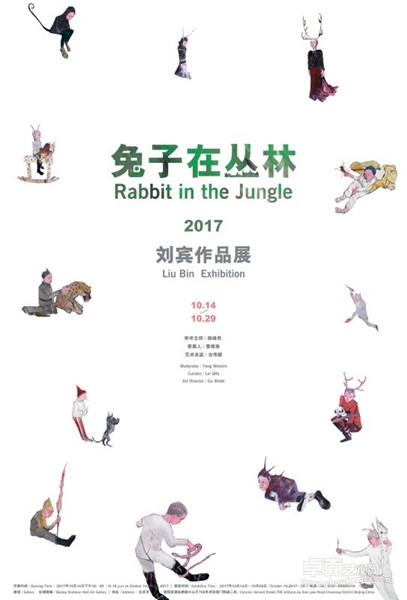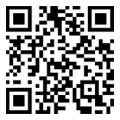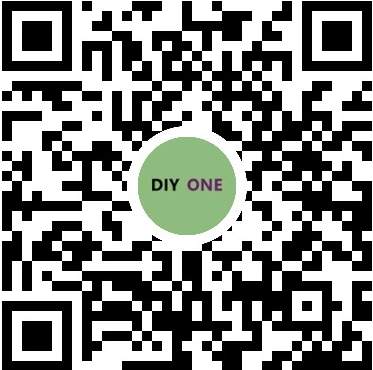
兔子在丛林——刘宾作品展
文/刘振
美术学博士、天台山文化研究院研究员
读小人书是童年时的一大乐事,虽然那时候还不识字,却也看得津津有味。由于不认识画面下方的文字,我们发挥想象,把一页一页的画面重新“编”成一个故事,甚至把自己也“编”故事里。

对于童年的心灵来说,生活的每一页画面下面,都是大人们的话语。对这些话语,我们也不甚明了。结果,我们无意间磨练出的想象力就派上用场,把生活的画面也编成故事,我们就在故事里。
有时,我们甚至完全不需要现实的画面,就能编出一两段故事了。故事都是白日梦,我们却总是瞪圆了眼睛做这个梦。这是我们自由的领地,异想天开、无拘无束,是大人们不知道的所在。这样的领地,甚至会终其一生珍藏在我们的心灵,不向任何人打开。

这似乎是不需外学的本能,在我们长大后也能发挥作用。每幅生活画面的下面,并不都有文字、话语的说明,即便有,也往往很不充分。这倒重新激发了我们的想象,把生活编成一个像样的故事。生活充满了束缚,却也到处是自由的领地。生活中不能没有别人,我们却总有别人进不到的地方。得意!

儒家的教诲是“慎独”,即便独处时也应自律。但是在这没有充分说明的生活中,哪里才算是独处的地方呢?也许正是这个我们自由的地方。我们是自由的,我们珍惜这种自由,舍不得让人知道,这也是慎独。

我们独处在满是别人的地方。我们还可以对这个地方尽情地“装饰”,装饰上千奇百怪,蛇、骷髅、小河,召之即来,无需备案,也不用任何文字、话语缀在画面下面。这装饰是自由的,不受文字、话语的约束。
我们甚至不受自己的约束。藏在这些装饰里,藏在自己创作的画面里,藏在丛林中,藏在兔子的面具下。是我们藏着么?还是我们本来就和丛林是一体的?也许我们本来就是丛林里的兔子。

对于从乡下迁到城里的小孩来说,更是如此。乡间的丛林变成了水泥森林,水草的味道变成了煤尘的味道。那些在乡间编成的故事,突然间全不适用了。那个自由的领地还在么?小孩总是倔强的,不愿舍弃那乡间的故事,就先在心里收藏起那勃勃的生机,然后对城市另起炉灶。
我们竟然似乎有了两块自由的领地,多么奇怪!究竟哪一块才真正是我们的呢?我们也许会从一块迁到另一块,或者今天藏在这一块,明天藏在另一块,自由的迁徙在自由的领地,又似乎是不得不迁徙。每一块都是自由的,却又互不相属,自由在这里断裂了。我们还自由么?
不仅是两块领地,好像连小孩的心也成了两颗。一颗藏着乡间的故事,这颗心永远保留在了童年;一颗编者城里的故事,半路出家地成长着。哪一颗是真的呢?抑或是不一不异、不断不常,这也许只有那双佛眼能看到。
可是,对于那乡间成长过的孩子来说,倒宁愿藏在那已经消失的画面里吧。
2011-11-21
Rabbit in the Jungle
Reading comic books is a great delight of childhood. Although we were illiterate at that time, we read with relish. Not knowing the text below the picture, we recompiled pages of pictures into a new story with imagination, and even put ourselves in the story.
For the soul of childhood, adults' words were at the bottom of each page of life scenes. We were not clear about these words. As a result, the imagination we inadvertently honed came in handy. We compiled scenes of life into a story, and we were in the story.
Sometimes, we didn't even need a realistic picture to create one or two stories. The stories were daydreaming, but we dreamed with eyes wide open. This was our free territory where we were whimsical and unrestrained, and it was a place unknown to the adults. Such territory might even be a lifetime treasure in our hearts, unrevealed to anyone.
It seems an instinct which also plays a role after we grow up. There aren't always texts or explanations below each scene of life. Even there is, it is often very inadequate. This stimulates our imagination to make life into a decent story. Life is full of constraints as well as freedom. We can't live without others, but we can always have a private place. Proud!
Confucianism instructs us to be "discreet in privacy", i.e. to have self-discipline even when alone. But in the life without full description, where is the place to be alone? Maybe it is the place where we are free. We are free and we cherish this freedom, could not bear to let people know. This is also self-discipline.
We are alone in a place full of others. We can also luxuriate in "decorating" it with strange things such as snake, skull and creek. They can be ready at a moment's notice without being put on records or attached with any texts or words. The decoration is free, unbound by texts or words.
We are not even bounded by ourselves. We hide in these decorations, in pictures we create, in the jungle and under the masks of rabbits. Are we hidden? Or are we essentially part of the jungle? Maybe we are originally rabbits in the jungle.
This is especially true for children who move from the countryside to the city. The jungle of the countryside turns into a cement forest, and the smell of aquatic plants becomes that of coal dust. The stories made up in the countryside are suddenly not applicable. Is that free territory still there? Children are always stubborn, unwilling to give up rural stories. So they first collect the vigorous vitality in the heart, and then start all over again in the city.
We seem to have two free territories, how strange! Which on earth truly belongs to us? We may move from one to another, or hide in this one today and in the other tomorrow. We migrate freely between free territories, yet we seem to be forced to do so. Both of the territories are free, yet not belong to each other. Freedom cracks here. Are we still free?
It's not just about two territories. Even the children seem to have two hearts. One conceals stories in the countryside and forever remains in the childhood, while the other makes up stories in the city and grows from halfway. Which one is true? Or neither is real or permanent? It maybe takes a Buddha to see.
However, for children who grow up in countryside, I guess they would rather hide in the picture that has disappeared.
Liu Zhen
November 21, 2011
兔子在丛林 —— 刘宾作品展
学术主持 / 杨维民
策展人 / 雷祺发
艺术总监 / 古伟碧
开幕时间:2017年10月14日下午16:00
展览时间:2017年10月14日—10月29日
展馆:北京虹墙画廊
地址:北京市朝阳区酒仙路大山子798艺术区南门陶瓷二街
Moderator / Yang Weimin
Curator / Lei Qifa
Art Director / Gu Weibi
Openg Time : At 16p.m On October 14 , 2017
Exhibition Time : October 14 , 2017—29
Gallery : Beijing Rainbow Wall Art Gallery
Address : Ceramic Second Street , 798 ArtZone , Jiu xian qiao Road , Chaoyang District Beijing , China






 皖公网安备 34010402700602号
皖公网安备 34010402700602号